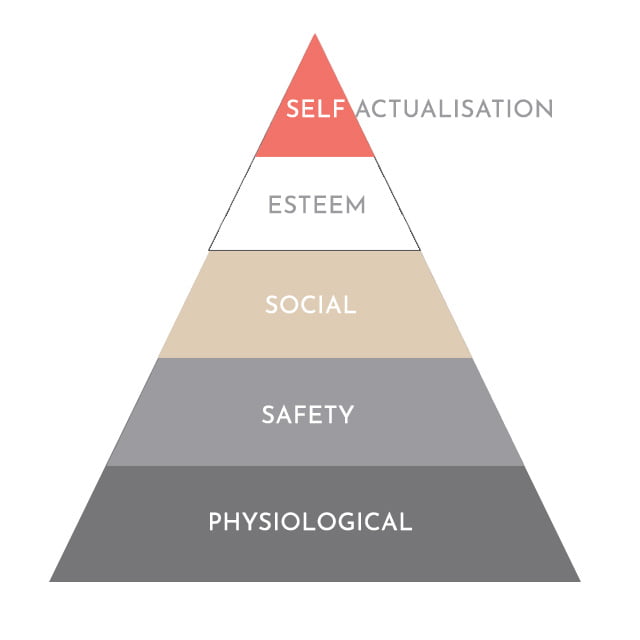This blog explores the relevance of Maslow’s Hierarchy of needs in life and business coaching today. Abraham Maslow’s Hierarchy of Needs is a psychological theory that proposes a hierarchical arrangement of human needs, ranging from basic physiological requirements to self-actualisation. Developed in the mid-20th century, Maslow’s theory has significantly influenced various disciplines, including psychology, sociology, and management. This blog aims to explore the continued relevance of Maslow’s Hierarchy of Needs in the context of life and business coaching today.
What exactly is Maslow’s Hierarchy of Needs?
Maslow’s Hierarchy of Needs consists of five levels arranged in a pyramid shape. At the base are physiological needs such as food, water, shelter, and sleep, followed by safety needs, including personal security, financial stability, and a sense of order. The next level encompasses social needs, such as love, belongingness, and the desire for interpersonal relationships. Esteem needs, which involve recognition, status, and self-esteem, occupy the subsequent level. Finally, self-actualisation, the highest level, represents the pursuit of personal growth, fulfilment, and realising one’s true potential.

The relevance of Maslow’s Hierarchy of Needs in Life Coaching today
Addressing Basic Human Needs:
Life coaching involves guiding individuals toward personal growth and well-being. By understanding Maslow’s Hierarchy of Needs, life coaches can identify and prioritise the unmet needs of their clients. For instance, if a client is struggling with financial instability or a lack of social connections, addressing these needs becomes fundamental to enabling further personal development. Coaches can work with clients to develop strategies that help satisfy their physiological, safety, and social needs, laying the foundation for their overall well-being.
Motivation and Goal Setting:
Maslow’s theory emphasises that higher-level needs only become salient once lower-level needs are satisfied. Life coaches can utilise this insight by assisting clients in setting appropriate goals and targets. For example, a coach may encourage a client to focus on fulfilling their basic physiological and safety needs before pursuing higher-level aspirations, such as self-actualisation. By aligning goals with the individual’s current level of need, coaches can ensure that clients are motivated and adequately supported throughout their personal growth journey.
Self-Actualisation and Personal Fulfilment:
Self-actualisation represents the pinnacle of Maslow’s pyramid, reflecting the desire for personal fulfilment and reaching one’s highest potential. Life coaching, informed by Maslow’s theory, can help clients explore their passions, values, and strengths. Coaches can provide guidance and strategies to align their clients’ lives with their self-actualisation aspirations, fostering a sense of purpose, happiness, and personal growth.
The relevance of Maslow’s Hierarchy of Needs in Business Coaching
Employee Motivation and Engagement:
Businesses can apply Maslow’s Hierarchy of Needs to understand and address the motivation and engagement levels of their employees. By recognising the importance of fulfilling employees’ basic physiological and safety needs, organisations can create a supportive work environment that fosters trust, security, and overall well-being. Additionally, businesses can promote social connections and a sense of belongingness through team-building activities and a positive workplace culture. Meeting these foundational needs establishes a solid groundwork for higher levels of employee motivation and commitment.
Leadership and Employee Development:
Business coaches can draw upon Maslow’s theory to guide leaders in their interactions with employees. Understanding that esteem needs, including recognition and respect, are crucial motivators, coaches can encourage leaders to provide feedback and acknowledge the achievements of their team members. Moreover, coaching can help leaders identify and support the self-actualisation aspirations of their employees, fostering a sense of personal growth, job satisfaction, and loyalty.
Organisational Culture and Purpose:
Maslow’s theory can also inform the development of an organisation’s culture and purpose. By considering the diverse needs of employees at different levels of the hierarchy, businesses can create a culture that values individual well-being, personal growth, and a sense of purpose. This holistic approach promotes employee engagement, productivity, and organisational success.
Conclusion
Maslow’s Hierarchy of Needs continues to be highly relevant in the fields of life and business coaching today. It provides a comprehensive framework for understanding human motivation, goal setting, and personal development. By recognising the importance of satisfying basic needs and promoting self-actualisation, coaches can guide individuals toward greater well-being and fulfilment. In business coaching, Maslow’s theory informs strategies for enhancing employee motivation, engagement, and leadership effectiveness. Organisations that acknowledge and address the diverse needs of their employees can cultivate a positive work environment, fostering personal growth, job satisfaction, and overall organisational success. As we navigate the complexities of human behaviour, Maslow’s Hierarchy of Needs serves as a timeless model, guiding both individuals and businesses towards a more fulfilling and purposeful existence.




